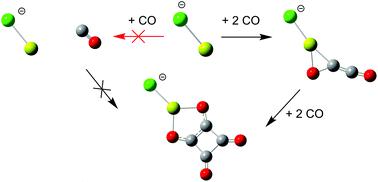当前位置:
X-MOL 学术
›
Org. Biomol. Chem.
›
论文详情
Our official English website, www.x-mol.net, welcomes your
feedback! (Note: you will need to create a separate account there.)
The unimolecular dissociation of magnesium chloride squarate (ClMgC4O4−) and reductive cyclooligomerisation of CO on magnesium
Organic & Biomolecular Chemistry ( IF 2.9 ) Pub Date : 2020-11-09 , DOI: 10.1039/d0ob01994a Joakim S. Jestilä 1, 2, 3, 4 , Zsuzsanna Iker 5, 6, 7, 8 , Mauritz J. O. Ryding 1, 2, 3, 4 , Einar Uggerud 1, 2, 3, 4
Organic & Biomolecular Chemistry ( IF 2.9 ) Pub Date : 2020-11-09 , DOI: 10.1039/d0ob01994a Joakim S. Jestilä 1, 2, 3, 4 , Zsuzsanna Iker 5, 6, 7, 8 , Mauritz J. O. Ryding 1, 2, 3, 4 , Einar Uggerud 1, 2, 3, 4
Affiliation

|
In this paper, we present an investigation of the unimolecular dissociation of an anionic magnesium chloride squarate complex, ClMgC4O4− using mass spectrometry supported by theoretical reaction models based on quantum chemical calculations. Sequential decarbonylation is the main fragmentation pathway leading to the deltate and ethenedione complexes, ClMgC3O3− and ClMgC2O2−, and MgCl−—yet the monomer, ClMgCO−, is not observed. Calculations using the G4 composite method show that the latter is unstable with respect to further dissociation. The implications for the reverse reaction sequence, cyclooligomerisation of CO on MgCl−, are discussed in detail and also compared with recent results from synthetic efforts in finding benign and efficient metal catalysed pathways to squaric acid from CO by reduction. It appears that the first step in these reactions, the formation of the first C–C bond by coupling of two CO molecules on MgCl−, is the most critical. The role of electron transfer in step-by-step stabilising the nascent CnOn centre is highlighted.
中文翻译:

氯化镁方酸(ClMgC4O4-)的单分子解离和CO在镁上的还原性环寡聚
在本文中,我们提出了一种的阴离子氯化镁方酸二复杂单分子解离的调查,ClMgC 4 ö 4 -使用基于量子化学计算由理论反应模型支持质谱。顺序脱羰是主要裂解途径导致deltate和ethenedione络合物,ClMgC 3 ö 3 -和ClMgC 2 ö 2 - ,和氯化镁- -可是单体,ClMgCO -,未观察到。使用G4复合方法进行的计算表明,后者对于进一步解离是不稳定的。用于反向反应顺序的影响,CO上的MgCl的cyclooligomerisation - ,进行了详细讨论,并且还与来自合成的努力中通过还原从CO发现良性和高效的金属催化途径方形酸最近结果进行比较。看来,第一步骤在这些反应中,通过上的MgCl 2个CO分子的耦合形成第一个C-C键的- ,是最关键的。强调了电子转移在逐步稳定新生C n O n中心中的作用。
更新日期:2020-11-13
中文翻译:

氯化镁方酸(ClMgC4O4-)的单分子解离和CO在镁上的还原性环寡聚
在本文中,我们提出了一种的阴离子氯化镁方酸二复杂单分子解离的调查,ClMgC 4 ö 4 -使用基于量子化学计算由理论反应模型支持质谱。顺序脱羰是主要裂解途径导致deltate和ethenedione络合物,ClMgC 3 ö 3 -和ClMgC 2 ö 2 - ,和氯化镁- -可是单体,ClMgCO -,未观察到。使用G4复合方法进行的计算表明,后者对于进一步解离是不稳定的。用于反向反应顺序的影响,CO上的MgCl的cyclooligomerisation - ,进行了详细讨论,并且还与来自合成的努力中通过还原从CO发现良性和高效的金属催化途径方形酸最近结果进行比较。看来,第一步骤在这些反应中,通过上的MgCl 2个CO分子的耦合形成第一个C-C键的- ,是最关键的。强调了电子转移在逐步稳定新生C n O n中心中的作用。











































 京公网安备 11010802027423号
京公网安备 11010802027423号